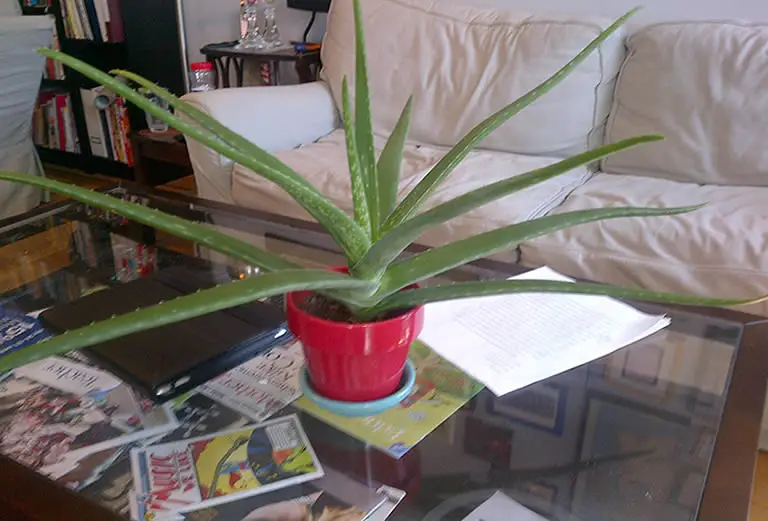In this article I cover everything you need to know to care for an aloe plant, this includes aloe vera and all of the other 550 aloe plant varieties.
I give you detailed information on everything from soil, light, heat and pot requirements to the plant’s water needs.
Table of Contents
- Aloe care basics for a healthy vibrant plant
- Aloe make perfect houseplants – but only when they get the right care
- Making sure your aloe is growing in the correct soil is important
- You should use a pot with good drainage, that also promotes higher humidity
- Getting the light requirements right for aloe is essential if you want a vibrant plant
- Aloe plants will feel comfortable in normal household temperatures
- Your aloe watering care routine must be 100% correct – this is critical for the health of your plant
- Applying aloe plant fertilizer requires precision
- When & how aloe plants bloom
Aloe care basics for a healthy vibrant plant
The aloe plant is very popular and is grown throughout the US mostly as a houseplant.
In its natural habitat the aloe plant can survive long periods without water, in dry, hot conditions. As a desert succulent the aloe has evolved to thrive in resource-scarce environments where many other plants, including some succulents, would perish.
Aloe is a perennial tropical succulent, that when cared for correctly, will flower once per year. It is native to tropical parts of Africa, Madagascar, Jordan, the Arabian Peninsula and various islands in the Indian Ocean such as Réunion, Mauritius and Comoros.
There are 550 varieties of aloe plant with the most common and popular species being aloe vera. However, there are many different types of aloe grown as houseplants in the US and other parts of the world, and aloe vera is far from the only common one.
Luckily though, all aloe plants require the same care so you do not need to fret over which particular species of aloe you own. The information given in this article applies to all aloe plant species.
Before I give you the optimal care routine for looking after this succulent I will briefly touch on the subject of indoor and outdoor aloe plants and their basic care needs.
Aloe make perfect houseplants – but only when they get the right care
Although it is advisable to only grow aloe plants outdoors in certain climate zones, does this mean there are restrictions on when and where you can grow an aloe plant indoors?
Aloe plants can be kept at home in all US states even in the colder states, though additional measures may need to be taken to give the plant extra light and heat.
As most homes are kept at a consistent warm temperature year round, with low humidity, this provides a good environment for growing aloe plants.
As aloe are grown mostly as houseplants the following care information is applicable to all aloe houseplants from aloe vera to Aloe zebrina and everything in between. If you plan to grow an aloe outside then you should visit the article I linked to in the previous section above.
Aloe plant care indoors is pretty easy
The aloe plant is an easy-care succulent that requires very little effort past the initial setup phase.
If you get the basics right and ensure the plant is growing in the correct medium with all its basic needs met via the environment it is growing in, then you will have to do very little care maintenance other than occasionally watering the plant.
So, let’s look at those basics now.
Making sure your aloe is growing in the correct soil is important
Aloe plants are desert succulents that grow wildly in sandy soil or rocky areas. This is why cactus soil works best for aloe houseplants.
Cactus soil offers great water drainage (which is essential for aloe plants) and is not too nutrient-rich for this light-feeding succulent.
Regular potting soil is far too rich for an aloe plant and should never be used unless it is mixed with the correct quantities of sand and perlite.
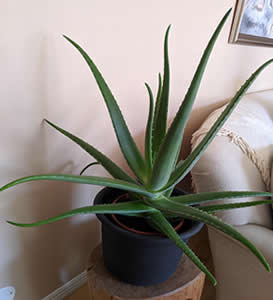
A mixture of perlite, sand and compost is the most common homemade soil used for growing aloe plants though a good draining cacti soil works just as well.
Aloe plants are very light feeders and this why regular potting mix, or compost, is too rich for these succulents. As they have evolved to grow in tropical desert environments, aloe plants thrive in gritty, sandy soil.
Another reason to avoid using a regular potting mix is that this type of soil will also retain far too much water for an aloe plant.
Water retention in the soil leads to a whole host of problems the most dangerous of which is root rot – a subject that I will touch on later though you can read more about it in the article on aloe vera root rot.
You should use a pot with good drainage, that also promotes higher humidity
For all the reasons given above, aloe plants require pots that have excellent drainage.
Drainage is vitally important when growing succulents, especially aloe plants.
Pots without drainage will hold on to too much water and create a host of problems with your plant.
The most serious problem you can encounter in an aloe plant that has been allowed to sit in water-drenched soil is root rot. This is a plant killer.
As I will cover later, an aloe plant requires very little water compared to other plants and even compared to some other succulents.
The simple truth is, if aloe gets too much water it will rot and die. So, a pot that has good drainage is essential so excess water in the soil can drain away.
Due to the need for good drainage I also encourage aloe plant growers to use terracotta pots.
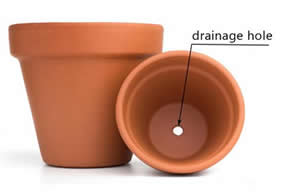
Although aloe plants do not require higher than normal humidity levels most American homes are quite dry. So, creating a little extra humidity around an aloe plant can be helpful.
Terracotta naturally “sweats” moisture from the pot. It wicks away moisture from the soil.
This moisture then seeps through the terracotta to form small droplets of water on the outside of the pot. This water then evaporates into the air increasing local humidity directly around the plant.
This wicking, or sweating, effect thus helps to reduce water-retention in the soil while simultaneously creating higher levels of humidity around the plant. This then provides moisture to the foliage but without the risk of drenching the soil (and thus the roots) via the use of a watering can.
This also helps keep the soil moist but not water-heavy or soaked.
And, in my opinion, terracotta really compliments succulents and looks great when used with aloe plants.
Of course you can use any type of pot you wish to as long as you ensure it has drainage holes.
For more detailed information on both the soil requirements and the pot requirements of the aloe plant read this article.
Getting the light requirements right for aloe is essential if you want a vibrant plant
Aloe plants grow wildly in areas that get a lot of direct strong sunlight. All aloe plant species has evolved to thrive in direct sunlight.
As the aloe is a light feeder it gets a large portion of its energy needs through photosynthesis so it needs access to plenty of light.
An indoor aloe plant must be given a minimum of 6 hours of direct sunlight per day if it is to remain healthy and produce blooms.
This is the minimum requirement. If possible try to ensure your aloe plant gets 7 – 8 hours of good direct sunlight per day if you want it to produce flowers.
If your aloe houseplant is placed in an area where light is scarce, and where the plant will not get its daily recommended amount of light, you should consider using a grow light.
Grow lights come in all shapes and sizes though my favorite types are small pot-based ones, like this, which produce not only extra light but also give produce additional heat in the localized environment directly around the pant.
They also look good enough to enhance the plant décor appeal rather than detracting from it as many larger grow lights do (at least in my opinion).
Read our article Do Aloe Plants Need Sun for more detailed information on the light requirements of the aloe plant.
Aloe plants will feel comfortable in normal household temperatures
Now, light is not the only thing that the sun provides an aloe plant.
The heat that the sun provides is also important. In the natural tropical desert habitats of aloe plants, temperatures will often be around 80°F in summer with some areas experiencing temperatures as high as 90°F.
Most homes in the continental US are kept at a consistent temperature range between 68°F and 76°F year-round.
As the best temperature for growing aloe plants falls between 50°F and 80°F you can see that the average US home falls nicely into this range.
As I stated previously, a grow light can give your plant extra heat in addition to extra light.
So, if you live in a home that is usually kept cooler than normal, or you find that your plant is not growing as well as it should be, then using a grow light to increase the localized temperature around the plant can really help.
The extra light from a grow light will not do the plant any harm even if it has access to good direct sunlight as long as you do not leave the light on 24 hours a day.
6 – 8 hours of artificial light is usually sufficient though 10 – 12 hours will not harm the plant.
Your aloe watering care routine must be 100% correct – this is critical for the health of your plant
The watering schedule, as far as aloe plants goes, is the most important part of your entire care routine!
In all my years of gardening I can say that 90% of the time when I have encountered a health problem with an aloe plant it has been due to incorrect watering.
Problems arising due to underwatering are very rare when it comes to aloe plants because these desert succulents are designed to live in water-scarce areas and to go long periods without it.
How long can an aloe vera plant live without water?
An aloe plant can live 4 weeks without water comfortably before showing signs of dehydration.
You could say these plants are built for water-deprivation. So, as you can imagine, underwatering is a fairly rare occurrence with aloe plants.
However although underwatering can be a problem, albeit a rare one, it is overwatering that is the biggest cause for sick aloe plants, at least in my experience.
An aloe plant should, on average, be watered only once every 3 weeks. It is when the top layer of soil, a few inches down, becomes dry that it is time to water the plant.
If you water an aloe plant when the soil is still moist then you are overwatering it and the plant will develop root rot.
For full information on the watering requirements of aloe plants, including aloe vera, and for instructions on how to avoid and treat issues related to incorrect watering (such as root rot) read our aloe plant watering care guide.
Applying aloe plant fertilizer requires precision
Although aloe plants are light feeders they still need additional nutrients from time to time.
You should only feed an aloe plant during the blooming stage of its growth. And, you should only feed the plant once per year and no more.
Overfeeding an aloe plant can lead to leaf problems and root rot just as easily as overwatering can.
It is also important that you do not give your aloe plant full strength fertilizer when you do feed it.
Unless you are using a fertilizer that has been developed exclusively for aloe plants, or aloe vera, then you should always make up the fertilizer to half the strength that is recommended on the product label. This includes succulent feed!
If you would like detailed information on growing aloe plants from seed and/or cuttings read our guide to growing aloe plants.
You may also be interested in reading our tips for making an aloe plant grow bigger and faster in our article how does aloe vera grow as well as our article on cutting an aloe plant for propagation or for latex harvesting.
When & how aloe plants bloom
An aloe plant will can a bloom time that is dependent on the species of aloe as well as the local climate zone – even when grown indoors.
Aloe plants in USDA climate zones 7 through 9 may bloom May – March.
In zones 9 and 10 an aloe plant will may bloom March – April.
In zones 10 through 12 you will often see an aloe plant produce a summer bloom.
However, having said that. on average indoor aloe plants will bloom in winter or spring if the temperature and lighting conditions in the home are normal.
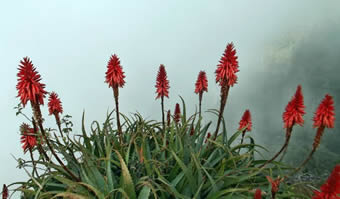
What should you do if your aloe plant does not bloom?
How to get a non-blooming aloe plant to flower
Believe it or not there are many aloe plant owners who are not even aware that their plant is supposed to bloom.
Due to a poor care routine, which is mostly down to insufficient light, many indoor aloe plants never produce flowers. Many houseplant owners, that have never seen their aloe plant bloom, therefore mistakenly believe the plant is incapable of flowering.
If you have an aloe plant that has never bloomed, or one that has stopped blooming, then your first action should be to give the plant more light.
Aloe plants will bloom once per year, year-on-year, for decades when they are cared for correctly.
Although insufficient light is by far the biggest factor in a non-blooming aloe plant there can be other causes which are usually evident in the leaves.
Root rot is the most common cause behind leaf problems and can be quickly identified when leaves begin to turn brown and become mushy at the base.
There is also often an associated smell with aloe plants that have root rot.
To ensure an aloe plant blooms you must place it in a location that gets 6 – 10 hours of direct light and that has a temperature range between 50°F and 80°F – aim to get closer to the higher end of the range.
If the plant still refuses to bloom use a grow light and consider repotting it in fresh soil.
Of course all this action will only be effective if you have a mature plant. It takes aloe plants about 4 years to mature enough to produce flowers.
For more information on aloe flowers, their care and their blooming cycle, read our article about aloe blooms.
The do’s and don’ts of using aloe plants outside
I often get asked if it is possible to grow an aloe plant outside either directly in the garden or in pots that are kept outdoors.
An aloe plant should only be grown outside year-round, in pots or in garden soil, in USDA climate zones 10 and 11.
A potted aloe plant can be kept outside in climate zones 8 and 9 year-round but only when given winter protection and protection from rainfall.
An indoor aloe plant can stay outside in the summer in locations that don’t experience temperatures below 40°F.
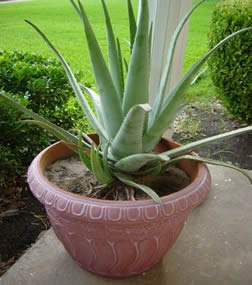
In their native habitats aloe plants can experience temperatures that rise as high as 90°F and that have little, to no, humidity.
So these blooming perennials are conditioned to require warmth to survive.
In areas of the US that have tropical climates the soil and the temperatures are ideal for growing aloe plants year-round outdoors either directly in the yard or in pots.
In USDA climate zones 8 and 9 it is possible to grow aloe plants outdoors though they will grow best in pots with cactus soil rather than in the yard.
During the winter, in these climate zones, the aloe must be given adequate winter protection or brought indoors as frost and low temperatures will likely kill the plant.
Other parts of the US are too cold to keep an aloe plant outdoors in every season and so the plants should only be moved outside during the warm summer months.
For more detailed information about growing aloe plants outside and moving potted aloe plants outside read this article.

